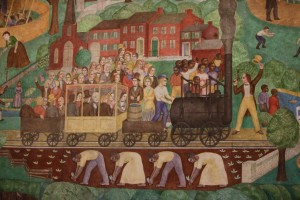
By Julianne Malveaux
NNPA News Wire Columnist
The University of Kentucky at Lexington (the flagship college), has shrouded an indoor mural that features paintings of enslaved African Americans bending to pick tobacco (or possibly cotton) while a train full of White folks seems to appear on their backs. There are other offensive images in the painting, but in many ways the painting reflects a Kentucky reality. Yes, there was oppression. The artist captured a reality that others might not find popular. University President Eli Capilouto agreed to cover the mural so that the campus has an opportunity to discuss it.
While students object to the mural painted by Ann Rice O’Hanlon, a University of Kentucky alumna, the Fresca reflected reality through her lens. Some might argue that it was a relatively liberal lens, since it captured an enslavement that many would prefer not to talk about. I’m concerned that African American students are “offended” by our depiction in history. That which O’Hanlon has depicted is real.
Should the mural be removed? Or, should its depiction be balanced. Enslavement was real. It is history. There is no purpose served by attempting to eliminate history. The mural might be a learning experience if a work by an African American artist, offering a different depiction of the period, would be observed in the same building, ideally perhaps in the same space. Then, the space might evolve into a space where history classes or discussion groups could grapple with the history of a state-funded university (which means black people’s taxes) that did not admit African Americans until 1949.
I am excited that student activists are stepping up and speaking out about the racist and Confederate symbols that are woven into the very existence of our nation. I am repulsed whenever I have to drive down “Jefferson Davis Highway” in a Washington, D.C. suburb (and initially designed to go from Virginia to California) wondering why a loser like Davis (the Confederates did lose the war – imagine Hitler Avenue in Germany) gets an interstate highway named for him. The Davis Highway is not the only elevation of a loser racist South of the Mason-Dixon line. Indeed, students (and others) are right to protest the glorification of racists and racism. But those who protest racist symbols must also be aware that it is easier to lower a flag, shroud a painting, or remove a name from a building or road than it is to tackle the root causes of institutional racism.
There has been a laudable increase in student activism that has garnered necessary national attention. At the University of Missouri, Black student outrage, combined with the financial pressure applied by the football team (whose unwillingness to play a scheduled football game would have cost the university one million dollars), pushed both a president and a chancellor out of their jobs. At Harvard University, where the designation of undergraduate facility leaders as “house masters” has been long-debated, the university has now decided to change the way they address those in that position. At Princeton University, students decrying Woodrow Wilson as a virulent racist (which is nothing but the truth) have demanded that his name be removed from college buildings. Kudos to these student activists and to their demands. Still, symbolism is not enough. How will changing the term “house maters” to “house leaders” (my suggestion) change the institutional relationships between the school and marginalized students. Will Harvard hire more Black faculty? Pay more attention to black students? Or will the name change be symbolic and not substantive?
My feelings about the buildings and programs at Princeton University are similar. Woodrow Wilson’s racism caused many African Americans to lose jobs they’d scrambled hard to earn though a challenging government employment system. He cost Black people money and toppled some from solidly middle-class to working poor. Is that a legacy that should be deified? Still, unless the removal of Wilson’s name from buildings is coupled with substantive changes in university relationships with African Americans (including more faculty hires, more opportunities for African American students, more engagement in the community, etc.) changing a building name simply whitewashes the more critical issue of the ways African Americans have been exploited.
I’d be excited if one of these universities would acknowledge their debt to the enslaved African American people by establishing mechanisms to manage the reparations issues (provide dollars and encourage other institutions to do same). I’m not as excited about taking names off buildings or moving statues. After those symbolic things happen, business goes on as usual.
The #BlackLivesMatter movement has spawned a heightened awareness of structural racism, and students have been exactly right in challenging the symbol of this racism. If their efforts are to really matter, though, they must also deal with substance.
Julianne Malveaux is an author and economist based in Washington, DC. Her latest book “Are We Better Off? Race, Obama and Public Policy” will be released in 2015 and is available for preorder at www.juliannemalveaux.com.




